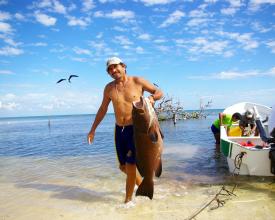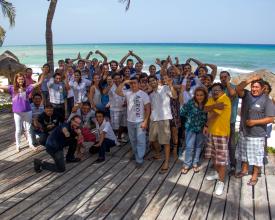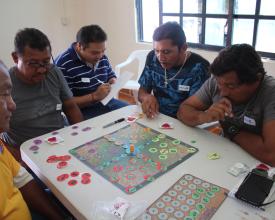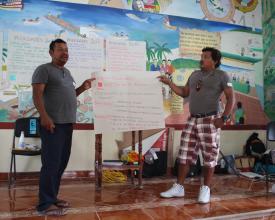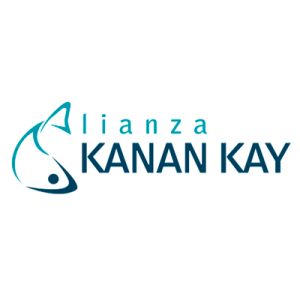
Impacto Colectivo: Pesca y colaboración intersectorial
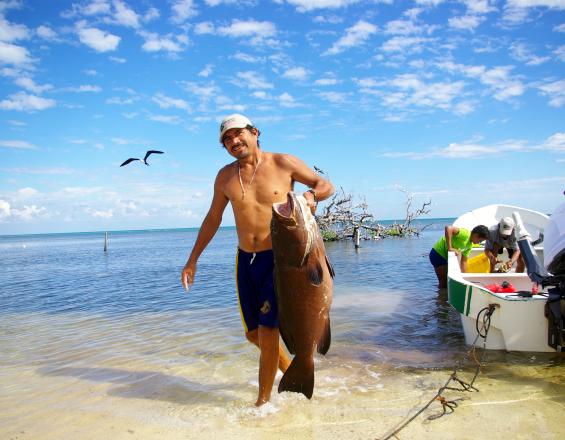
Quintana Roo (México) tiene una elevada productividad marina, pero la sobrepesca y el desarrollo costero están provocando el declive de ecosistemas clave debido a la contaminación y la pérdida de hábitats. El cambio climático es un factor de estrés adicional para este entorno ya afectado. La falta de participación de los pescadores artesanales en la gestión pesquera ha dado lugar a una extracción insostenible de especies. Para posibilitar el cambio y facilitar la colaboración en pro de la conservación, se fundó la Alianza Kanan Kay, una coalición intersectorial que promueve la responsabilidad compartida a través de la acción colectiva. Su objetivo es proteger el 20% del mar territorial a través de una red de refugios de peces, fomentando la participación de los pescadores en la gestión pesquera.
Contexto
Défis à relever
Medio ambiente:
- Sobreexplotación de las poblaciones pesqueras.
- Falta de herramientas eficaces de gestión adaptativa, especialmente ante el cambio climático.
- La cobertura de las zonas de pesca prohibida sigue siendo escasa.
- Necesidad de una protección sostenida en el tiempo, y de mayores superficies, para comprender y evaluar todos los impactos ecológicos.
- Falta de conectividad efectiva entre las zonas de veda.
Social:
- La aplicación deficiente de la normativa es la principal amenaza, no sólo para la reposición de la biodiversidad, sino también para la aceptación y el apoyo social de esta herramienta de gestión pesquera.
- Los refugios pesqueros son una estrategia bastante nueva en México, dado que las primeras zonas de veda acaban de ser renovadas por primera vez a nivel nacional y no tienen más de 5 años de antigüedad. Esto genera incertidumbre sobre los mecanismos de participación del sector pesquero en la definición de políticas públicas.
Económicas:
- Necesidad de evaluar los servicios de los ecosistemas y evaluar el valor medioambiental.
- Necesidad de mejorar las herramientas para comprender y aplicar soluciones de economía azul.
Ubicación
Procesar
Resumen del proceso
Teoría del cambio basada en los pasos necesarios para fomentar el impacto colectivo:
- Empoderamiento de los pescadores. Antes de empezar a trabajar con las comunidades costeras es necesario realizar un diagnóstico exhaustivo de la situación socioeconómica de las organizaciones pesqueras. Esto incluye un análisis de las carencias y, por último, el desarrollo de capacidades.
- Una vez comprendido el universo socioeconómico, la organización vertebradora (Kanan Kay Alliance) fomenta la colaboración intersectorial y realiza un seguimiento.
- Ha llegado el momento de trabajar sobre el terreno. Es crucial lograr resultados concretos y tangibles en las primeras fases para que se mantenga el impulso y la motivación para el cambio. En la Alianza, optamos por hacerlo aplicando una herramienta específica de gestión de la pesca (los refugios para peces).
- Es necesario abordar la compensación financiera para demostrar que los esfuerzos de conservación no se enfrentan al crecimiento económico sostenible. Los pescadores participan en el seguimiento científico durante la temporada de veda y reciben una compensación por ello.
- Es crucial contar con un marco jurídico e institucional sólido para que la falta de aplicación no obstaculice el rendimiento general de la iniciativa.
Bloques de construcción
Capacitación de los pescadores
Para iniciar una estrategia de desarrollo de capacidades, primero se realiza un diagnóstico de la organización pesquera. Se capacita a los pescadores en diferentes temas como habilidades de liderazgo, monitoreo científico, vigilancia comunitaria, administración de organizaciones pesqueras, desarrollo humano. La formación corre a cargo de miembros de la Alianza, como organizaciones de la sociedad civil, otros pescadores, el mundo académico y organismos gubernamentales.
Factores facilitadores
- Apropiación y responsabilidad de la iniciativa por parte de los pescadores
- Participación activa de los pescadores
- Liderazgo sólido
- Instituciones con capacidad y voluntad de apoyar a los pescadores
Lección aprendida
Al aunar los temas sociales, medioambientales y económicos en las formaciones y no centrarnos únicamente en talleres relacionados con la gestión de recursos, hemos podido aumentar el impacto colectivo y mantenerlo en el tiempo. Reforzar los tres aspectos clave para la sostenibilidad ha sido fundamental. Hemos aprendido que nuestra mejor estrategia es la que proporciona habilidades de liderazgo, desarrollo humano, administración personal y organizativa, planes de negocio para cooperativas pesqueras o comercio justo. Hay que preguntar y entrenar a los pescadores para que descubran sus propias debilidades y fortalezas. Hay que invertir tiempo y recursos para incluir a los clientes en los proyectos de los pescadores.
Diseño y puesta en marcha de refugios para peces
Sobre la base de un proceso participativo ascendente, se establece una red de refugios de peces eficaz, legalmente reconocida y respetada a nivel local. Desde 2012 se han creado dieciséis refugios para peces, que abarcan más de 18 000 hectáreas.
Factores facilitadores
- Voluntad de las organizaciones pesqueras de mejorar las prácticas sostenibles y garantizar la pesca para las generaciones futuras.
- Objetivo común claro.
- Procesos participativos para diseñar los refugios de peces.
- Combinación de conocimientos científicos y ecológicos locales.
- El alcance temporal de los refugios de peces aumenta la confianza de los pescadores en el proceso y permite una gestión adaptativa.
- La decisión final de crear refugios para peces depende exclusivamente de las organizaciones pesqueras.
- Apoyo de la red de colaboración.
Lección aprendida
El conocimiento local-ecológico que aportan los pescadores sobre los recursos naturales, los caladeros y las condiciones climáticas, son elementos fundamentales a tener en cuenta en el diseño de un refugio para peces. Al combinar el conocimiento local-ecológico con el científico es importante que se inicie una negociación transparente que permita tener las mejores condiciones basadas en la ciencia con aceptación social.
A continuación, las organizaciones miembros de la Alianza Kanan Kay dirigen un programa de vigilancia comunitaria. Los pescadores y las mujeres reciben formación y participan activamente en la recogida de datos. Así, ven los resultados con sus propios ojos y pueden compartir la información con otros miembros de la comunidad. Una vez entregados los resultados del seguimiento, durante el proceso de renovación se revisan los objetivos de los refugios de peces para saber si cumplen los criterios biofísicos de las zonas de veda y, por tanto, si hay que hacer cambios.
Este enfoque "ascendente" debe complementarse con elementos "descendentes" para garantizar que la toma de decisiones refleje la complejidad de este proceso.
Colaboración intersectorial
La Alianza reúne a un grupo diverso de partes interesadas, sirve de foro de diálogo y facilita el intercambio de ideas, capacidades y experiencias, generando sinergias y soluciones mutuamente beneficiosas.
Factores facilitadores
- Agenda común. Permite ser claro y transparente sobre el objetivo principal de la iniciativa.
- Medición compartida. Es necesario establecer un conjunto de indicadores para medir los avances.
- Fomentar actividades que se refuercen mutuamente. Mediante una fuerte coordinación.
- Comunicaciones continuas. La confianza es clave; establecemos relaciones honestas entre los miembros.
- Organización vertebradora. La Alianza Kanan Kay cuenta con un comité coordinador representado por los miembros y dedicado a poner en marcha, coordinar y dar seguimiento a las actividades que se sumen para lograr un impacto colectivo.
Lección aprendida
Trabajar juntos como una plataforma de impacto colectivo no significa que hagamos todo juntos en todo momento. Se trata de cómo potenciar lo mejor de cada organización, respetando y comprendiendo al mismo tiempo los puntos fuertes y las áreas de oportunidad. Las comunidades deben tener un papel claro en la toma de decisiones, lo que nos lleva de nuevo al bloque de construcción nº 1 sobre el empoderamiento de los pescadores y la creación de capacidades.
Compensación financiera
Una combinación de fondos públicos y privados ayuda a compensar parcialmente a los pescadores por su participación en, por ejemplo, actividades de control biológico o asambleas generales.
Factores facilitadores
- El presupuesto cubre los gastos esenciales para que los pescadores puedan participar en diferentes actividades.
- Los refugios para peces se asemejan a un mecanismo de ahorro bancario que garantizará la propia actividad pesquera para las generaciones futuras.
- Los refugios para peces también benefician a las pesquerías a medio plazo debido al efecto de desbordamiento de la biomasa.
- Voluntad de los pescadores de participar y liderar esfuerzos.
- Las organizaciones tienen la voluntad y la capacidad de impartir formación a los miembros de la alianza.
- Comunicación: lenguaje apropiado para crear un entendimiento común.
Lección aprendida
Contar con el liderazgo y la apropiación de los pescadores en la Alianza refuerza y ayuda a la iniciativa. Los actores institucionales, académicos y organizaciones de la sociedad civil apoyan la acción colectiva basada en el empoderamiento de la comunidad de una manera que no lo hacían antes, porque respetan una premisa básica: si los pescadores no están de acuerdo y apoyan las acciones, la implementación no sería posible. Este enfoque permite además una comunicación más directa, una aplicación de los principios básicos de colaboración y una confianza creciente entre los participantes.
Marco jurídico e institucional
Se analiza y revisa el marco jurídico existente para la formación de refugios de peces. Se identifican herramientas para la gestión participativa de los refugios de peces, así como para las actividades de inspección y vigilancia.
Factores facilitadores
- Identificación clara de los instrumentos jurídicos disponibles, los requisitos y los procedimientos de aplicación.
- Persistencia en los procesos administrativos y políticos.
- Socialización del marco jurídico con los pescadores (talleres, reuniones y debates informales).
- Los talleres de vigilancia comunitaria para las organizaciones pesqueras son oportunidades para establecer relaciones de confianza.
- Análisis de brechas del sistema legal.
- Coordinación con las diferentes instituciones.
- Desarrollo de normas complementarias para fortalecer el marco legal.
- Presupuesto para la implementación.
Lección aprendida
El uso de herramientas de pesca en áreas protegidas fue un reto importante en el Caribe mexicano, y no siempre bien recibido por las autoridades a cargo de las áreas protegidas. Sin embargo, gracias a los argumentos técnicos y legales, en 2012 se establecieron legalmente las primeras zonas de refugio para peces en dos reservas de la biosfera. Esto fue posible gracias al intenso trabajo conjunto con los pescadores, varios años antes de que existiera la Alianza. Pero cuando se habla de marco jurídico e institucional, no basta con un enfoque participativo de abajo arriba. Algunos cambios legales requieren un trabajo de alto nivel dentro de la administración pública. Hay que esforzarse por equilibrar ambos enfoques. La Alianza Kanan Kay permitió combinar el estilo ascendente con el enfoque más descendente de las instituciones públicas, proporcionando el escenario para el debate y construyendo sobre un objetivo común.
Impactos
- Desde 2012 se ha establecido una red de 16 refugios de peces que protegen más de 18.000 hectáreas de arrecifes de coral, praderas marinas y humedales costeros.
- La primera generación de refugios para peces (zonas de pesca sin capturas) se ha renovado por un periodo de cinco años más, por iniciativa de los pescadores.
- Los pescadores llevan a cabo el seguimiento científico, la vigilancia comunitaria, participan en talleres de capacitación y son partes interesadas clave en la toma de decisiones.
- La Alianza Kanan Kay lleva más de cinco años funcionando como una red de colaboración que promueve el acuerdo sobre una agenda común, el establecimiento de medidas compartidas, el fomento de la colaboración cruzada
La Alianza Kanan Kay es una iniciativa voluntaria basada en miembros que pretende actuar como organización vertebradora para lograr un impacto colectivo. En ella participan unos 40 miembros del gobierno, cooperativas pesqueras, organizaciones de la sociedad civil, investigadores académicos y donantes privados. Se está trabajando para mejorar la gobernanza al tiempo que se refuerza el papel de las organizaciones pesqueras en esta red.
Beneficiarios
- Organizaciones pesqueras
- Organizaciones de la sociedad civil
- Gobiernos locales, regionales y nacionales
- Academia (investigadores)
- Iniciativa privada: Sector turístico (buceo, pesca recreativa) y empresas locales (pescaderías y marisquerías)
Objetivos de Desarrollo Sostenible
Historia
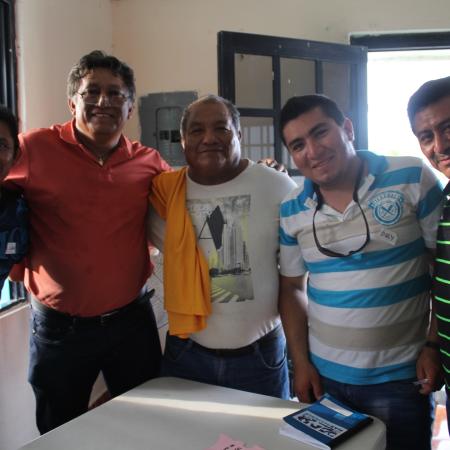
En una Asamblea General, los miembros de la Alianza Kanan Kay debatieron qué terminología utilizar para referirse a los "refugios de peces" frente a las "zonas de veda". Para algunos representantes gubernamentales, cambiar a un término diferente que fuera a la vez técnicamente correcto y fácil de entender tenía mucho sentido. Para los pescadores, sin embargo, cambiar el término habría sido sinónimo de traicionar el objetivo general de la Alianza. La discusión llegó a un punto en el que los pescadores estaban dispuestos a ejercer su poder de veto y abandonar la asamblea si se cambiaba el término. Al final, la Alianza decidió mantener el término, ya que era de gran importancia para los pescadores. Este incidente contribuyó a aumentar la confianza de los pescadores en un enfoque de gestión conjunta y en el éxito de su aplicación. Los pescadores se dieron cuenta de que los miembros eran socios en pie de igualdad, todos comprometidos con la misma misión de desarrollar una pesca responsable.
